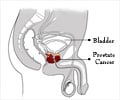Forgoing immediate surgery to remove the tumor or radiation poses no added risk of death, a Johns Hopkins study shows.

None of the men, mostly 65 and older, have so far died from prostate cancer since the study began in 1995. However, one-third of study participants, monitored for as long as 15 years, eventually underwent treatment, primarily because annual biopsy results showed more cancer.
The study, to be published in the Journal of Clinical Oncology and posted online ahead of print, is believed to be the largest and longest study of men initially diagnosed with a slow-growing, very nonaggressive form of prostate cancer. This means they stand very little chance of dying from the disease, which was classified as very low risk, in its earliest stage, called T1c.
"This study offers the most conclusive evidence to date that active surveillance may be the preferred option for the vast majority of older men diagnosed with a very low-grade or small-volume form of prostate cancer," says study senior investigator and urologist H. Ballentine Carter, M.D. "These are men with a favorable risk disease profile to begin with."
Carter, director of adult urology at The Johns Hopkins Hospital and a professor at the Johns Hopkins University School of Medicine and its Brady Urological Institute, acknowledges that "for some of these men, the prospect of living with prostate cancer is unbearable, and the tumor has to go." But, he adds, "the vast majority of these men are ideal candidates for active surveillance because they are older and are able to avoid the risks and complications associated with surgery and radiation." The best candidates for surveillance programs, he says, are those who can be relied on to keep their medical appointments.
Some 217,000 men in the United States are diagnosed each year with prostate cancer, the majority of them older than 65, and with a low risk of dying from the disease if treatment is deferred, Carter says. Yet, more than 90 percent of these men with low-risk disease, including some 80 percent of those over 75, are likely to choose some form of treatment instead of surveillance.
Advertisement
Possible complications from surgery or radiation to treat tumors, he says, primarily include incontinence, and other bowel, urinary or sexual problems.
Advertisement
The study showed that men who strictly met all study criteria for very low-risk disease were 30 percent less likely to be reclassified to a high-risk category during surveillance and need subsequent surgery or radiation than men who did not meet one or more study criteria.
All study participants, 90 percent white and 6 percent black, met the key criteria of having a prostate-cancer Gleason score of 6 or less. The score is used to rate the severity of the disease. Higher scores, typically from 7 through 10, suggest a more aggressive form of the disease that in most cases would require treatment.
Eighty percent of men involved in the latest analysis met at least one or more other study criteria for small-volume tumors. These included the amount of cancer found on biopsy of the prostate gland, plus a ratio of blood levels of a protein linked to the cancer, called prostate-specific antigen (PSA) to gland size, or PSA density. Fewer than three biopsy cores could have cancer, with the disease present in no more than half of any core. Most study participants had a PSA density of less than 15 percent.
Men were enrolled in the study from 1995 through 2010, and are being monitored through semiannual check-ups and yearly biopsy.
Carter's team plans next to expand the surveillance study program to other medical centers, including Cedars Sinai Medical Center in Los Angeles, to further refine their selection criteria.
Current guidelines endorsed by the National Comprehensive Cancer Network, he says, could be broadened as a result of the study and already list active surveillance as a preferred course of action for many older men, especially seniors.
The Hopkins team and the Prostate Cancer Foundation, which helped fund the latest study, have plans to develop a web-based educational program to directly promote active surveillance to men newly diagnosed with the disease. Another of the team's goal, he says, is to develop better screening tests for identifying men best suited to a surveillance program.
Source-Eurekalert



![Prostate Specific Antigen [PSA] Prostate Specific Antigen [PSA]](https://www.medindia.net/images/common/patientinfo/120_100/prostate-specific-antigen.jpg)




